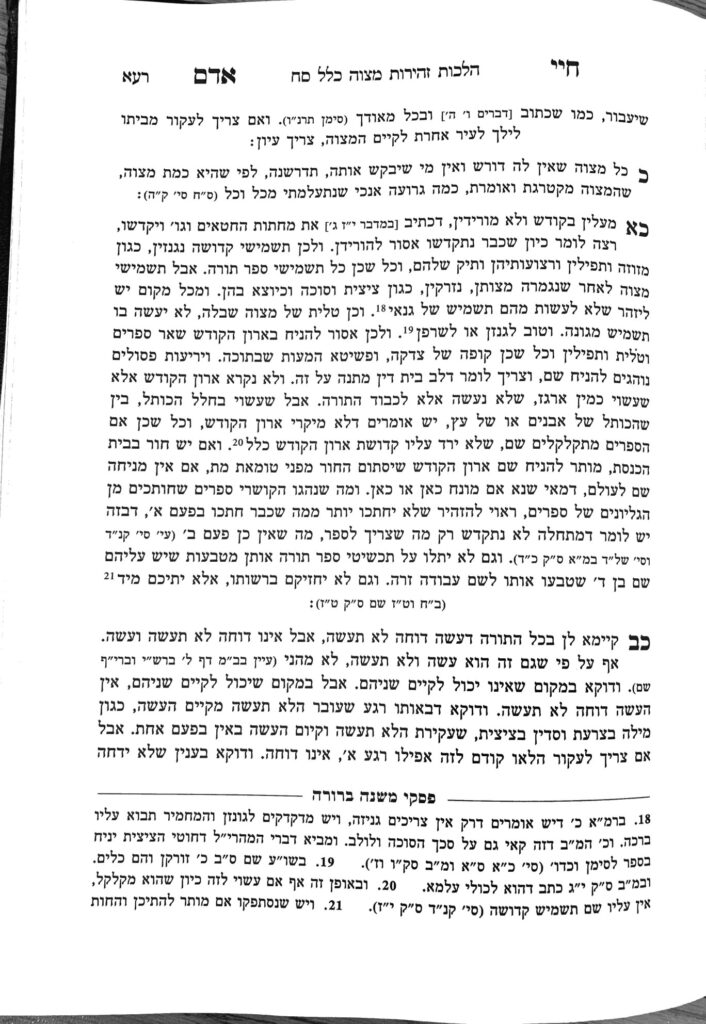We are continuing in siman 21, discussing the halachos of shaimos. Yesterday, we learned that the source of this halacha is the issur to destroy any of the seven names of Hashem. We can now understand why these halachos are referred to as shaimos, because they have to do with proper kavod to the sheim Hashem. However, we use this term to refer to the proper disposal of kisvei kodesh (such as a worn out Sefer Torah, or any sefer) as well. Even though proper disposal of kisvei hakodesh does not appear to be related to the shaimos of Hashem, it must be disposed of properly.
One suggestion of the connection is based on the Ramban in chumash, who says that the entire Torah is really a form of the name of Hashem. The names of Hashem are the vehicles through which Hashem is known in the world. The Ibn Ezra explains that the word sheim (name) and sham (there; a specific place) are spelled the same in lashon hakodesh because we cannot point to Hashem specifically, but we can see Him through His guidance and presence in the world. The Ramban continues, and suggests that the entire Sefer Torah is a name of Hashem as well, because the Torah is a vehicle through which we perceive Hashem in this world. Thus, we could understand that kisvei hakodesh are a form of the name of Hashem as well, so their disposal is referred to as shaimos.
Another understanding why there is a chiyuv of geniza is that since we know that removing a stone from a shul is problematic, certainly destroying kisvei hakodesh will be as well. This would not explain the reference to shaimos, but would explain why lo saasun kein applies to these other items. Colloquially, we refer to this as shaimos.
Generally, the issue with shaimos is not where someone wishes to actively destory shaimos, but wishes to leave it in a place where it will come to be destroyed, such as leaving the shaimos in an open area. Essentially, one is causing the shaimos to become destroyed through a grama, and the question becomes whether it is assur to destroy kisvei hakodesh through grama.
The Gemara in Shabbos, 120b, seems to say that destroying Hashem’s name through grama is not assur. The Gemara brings a case of a person who had Hashem’s name written on their arm, and wishes to go to the mikvah. Rav Yosi holds it is muttar to go to the mikvah, even though the water will erase the sheim, because it is destruction through grama.
However, the Noda B’Yehuda understands from our discussion over here that it is assur, and explains that the Gemara in Shabbos is discussing a case of a mitzvah, so it is not a full-fledged destruction. However, when there is no mitzvah, it is assur to cause destruction of shaimos through a grama.
In addition to the Noda B’Yehuda, the Chazon Ish points out an additional issue of kavod of seforim. If we are obligated to show kavod to seforim when we are using them, it is certainly a bizayon to leave them in a manner in which they will be destroyed even if only through a grama.
Summary
The halachos of geniza are referred to as shaimos because they are related to proper disposal of the shaimos of Hashem.
It is assur to cause Hashem’s name to be destroyed through a grama. If one needs to destroy Hashem’s name through a grama while performing a mitzvah, it may be muttar.



